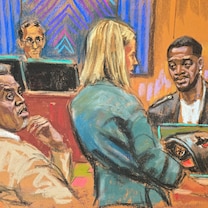New York Times Columnist Calls for a Green Revolution
Thomas Friedman writes that a green revolution will renew America.
Sept. 8, 2008 — -- In a follow-up to "The World Is Flat," his book about globalization, New York Times columnist Thomas Friedman brings a new perspective to climate change and the energy crisis.
In "Hot, Flat and Crowded," Friedman argues that the new presidential administration must take strong and decisive steps to create a green revolution in order to save the planet, "reknit America at home [and] reconnect America abroad."
Read a chapter from the book below.
Chapter 1: Where Birds Don't Fly
German engineering, Swiss innovation, American nothing.—Advertising slogan used on a billboard in South Africa by Daimler to promote its Smart "forfour" compact car.
In June 2004, I was visiting London with my daughter Orly, and oneevening we went to see the play Billy Elliot at a theater near VictoriaStation. During intermission, I was standing up, stretching my legs inthe aisle next to my seat, when a stranger approached and asked me, "Are you Mr. Friedman?" When I nodded yes, he introduced himself: "My name is Emad Tinawi. I am a Syrian-American working for Booz Allen," the consulting firm. Tinawi said that while he disagreed with some of the columns I had written, particularly on the Middle East, there was one column he especially liked and still kept.
"Which one?" I asked with great curiosity.
"The one called 'Where Birds Don't Fly,'" he said. For a moment, Iwas stumped. I remembered writing that headline, but I couldn't remember the column or the dateline. Then he reminded me: It wasabout the new—post-9/11—U.S. consulate in Istanbul, Turkey.
For years, the U.S. consulate in Istanbul was headquartered in thePalazzo Corpi, a grand and distinctive old building in the heart of thecity's bustling business district, jammed between the bazaars, the domed mosques, and the jumble of Ottoman and modern architecture. Built in 1882, and bought by the U.S. government twenty-five years later, Palazzo Corpi was bordered on three sides by narrow streets and was thoroughly woven into the fabric of Istanbul life. It was an easy place for Turks to get a visa, to peruse the library, or to engage with an American diplomat.
But as part of the general security upgrade for U.S. embassies andconsulates in the post-9/11 world, it was decided to close the consulate at Palazzo Corpi, and in June 2003 a new U.S. consulate was opened in Istinye, an outlying district about twelve miles away from the center of the city. "The new 22-acre facility—nearly 15 times as big as the old consulate—was built on a solid rock hill," a Federal Times article reported (April 25, 2005), adding that "State now requires buildings to have protective walls that are at least 100 feet away from embassies and consulates. Those walls and barriers also must protect against explosions and ramming attacks from vehicles, and they must be difficult to climb. Guard booths are placed at the perimeter of facilities, and windows anddoors are bulletproof and resist forced entries. The new buildings are also strong enough to resist most earthquakes and bombs."





